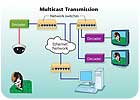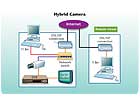
Megapixel cameras provide a larger image than traditional CCTV cameras.
The networking of surveillance video is proceeding at a torrid pace. With the ability to connect individual cameras, digital video recorders (DVRs), network video recorders (NVRs), and other physical security devices to Ethernet, Wi-Fi, and Internet connections well established, industry manufacturers are rapidly delivering products that introduce new technologies and applications for our industry.
Truly this is an exciting time for physical security integration companies, as these technologies offer a plethora of new services to provide for their clients. Networking video also opens the door to more proactive security scenarios, where questionable behavior of people or events can be detected during the act, as well as the later review of recorded video.
What are some of the new trends in networking video, and how can installation companies best utilize them? In this Field Guide, we’ll examine several of these new technologies, describe their impact on networking security video, and provide some details on their implementation.
MEGAPIXEL CAMERAS
Fueled by the rapid consumer acceptance of digital snapshot technology, the megapixel video camera is becoming a standard offering by high-end physical security integrators. These surveillance cameras sample millions of pixels in a single image, providing extremely high resolution and quality pictures for viewing and analysis.Although everyone involved with surveillance video would like to have the highest quality images from all cameras there is a price to be paid for placing megapixel surveillance cameras onto a network. Because of their large size, megapixel images can consume a large portion of available network bandwidth, while also requiring large-capacity storage drives.
There are a couple of ways that integrators are optimizing the use of megapixel cameras. The first is to only use a few “spot” megapixel cameras in locations where excellent image quality is needed, while lower-resolution cameras are used in other areas. For example, a megapixel camera might be installed at the extrance to a building so that the faces of individuals entering or leaving the building are clearly recorded, while lower-resolution cameras are used in other areas.
Another approach is edge recording, where the megapixel camera is directly connected to a nearby hard drive, while also being cabled onto the LAN. The local hard drive can record the megapixel images, and make them available for downloading by authorized personnel when review is needed. This approach can greatly reduce network bandwidth usage, as the large megapixel images don’t travel over the network unless they are requested.
Because of the emergence of video analytics (see p. 8) and the reductions in cost of megapixel technology, the industry will see some variation of megapixel imaging become commonly used within the next 10 years.

A hybrid DVR can be used to connect cameras from remote locations onto the same DVR to which local cameras are connected.
HYBRID DVRS
One of the issues confronting physical security integrators is how to best migrate existing analog systems into network video solutions. While the benefits of networked video are substantial, many clients have a large investment in their existing analog video surveillance systems and may not have the budget available to pay for an IP-enabled upgrade. One solution to this issue is the hybrid DVR, which combines the traditional analog camera inputs with the ability to view and record IP cameras or encoders.A typical use of a hybrid DVR is a situation where the client has a main building with pre-installed analog cameras and a remote building where cameras need to be installed. If the client wishes to record both the main and remote building on the same DVR – making the live and recorded video available from the same device – and the buildings have broadband Internet ISP service, then network cameras or encoders can be installed at the remote site. The network video can be received and recorded by the hybrid DVR, providing viewing of live and recorded video from both buildings onto the same monitor or remote-viewing computer.
It’s important to note that while most hybrid DVRs will accept an analog input from most any manufacturer’s cameras, connected network cameras usually must be from the same manufacturer as the hybrid DVR.
HYBRID CAMERAS
Another method available to incrementally migrate existing analog CCTV systems into networking is to use hybrid IP cameras, which provide a standard analog output along with a network connection in the same device. The advantage to these devices is that existing cameras can be replaced with a hybrid, which generally is a standard form-factor camera that can be used with various industry-standard lens, housings, and mounting hardware. A newly installed hybrid camera can send standard analog video to the existing monitor(s) and local recorder, while the network output provides a one-to-many video feed that can be viewed on local and/or remote network PCs.
Encoders can pass video streams over a network to a decoder, which provides an analog video output for a monitor.
ENCODER TO DECODER VIDEO
Networking video allows multiple users to view and manipulate video images from their desktop or laptop PC. Many clients would prefer to watch surveillance video on a television-style monitor, instead of a small computer screen. Industry vendors are now providing encoder-to-decoder video, so that a video feed can be transmitted over a network from an encoder to a decoder, which converts the network video data packets back into an analog signal for connection to a standard NTSC television monitor.Vendors are now producing useful product families that include IP hybrid cameras, encoders, and decoders, which are all based on matching software/firmware sets. These product families provide the capability for IP cameras and analog camera/encoder sets to be transmitted over a network, with the decoder providing a “quad” image output, so four video streams can be viewed simultaneously from a single decoder.
When considering this application, keep in mind that most product lines will provide for simultaneous video viewing by a group of authorized users. So while the video is being displayed on a TV monitor it also can be viewed on separate network computers.
POE
A standardized technology for distributing power for network appliances called PoE (Power over Ethernet) is making rapid strides in implementation and market acceptance. Initially conceived to provide power for VoIP telephone instruments, PoE supplies 350 milliamp/48 VDC current over the same two copper UTP pairs that transport 10/100 Ethernet over network cabling. Supplied by specific PoE-enabled network switches located in telecommunication closets, PoE current is typically provided by a UPS, which produces regulated voltage output along with a short duration of standby power in the event of power failure.PoE is an exciting new technology for security system integrators, as IP cameras and encoders that operate using PoE can be mounted without having to pull or install separate cabling, power supplies, or transformers to supply operating voltage to the security device. If an installing company wants to install PoE-enabled cameras and the local network switches are not PoE equipped, devices called mid-span PoE hubs can be placed in the telecommunications closet, connected to the UPS, and can provide PoE and Ethernet communications over a single Cat 5e four-pair cable out to the remote device or camera.
As PoE becomes a well-accepted device powering system for general networking use, the standards bodies are developing a new higher-current PoE standard that will provide enough current to operate specific pan/tilt/zoom IP cameras without the need for local or additional power supplies.
There have been some reports of problems when PoE is connected to substandard cabling, as small diameter copper conductors can result in high resistance and voltage drop over distance. When considering adding PoE to power cameras or other security devices, security integrators should be sure to use high quality CAT 5e or above listed cabling between the remote device and the PoE power source.

Multicasting distributes an identical video feed to viewing computers and decoders, while reducing network bandwidth usage when compared to one-to-one (unicast) video transmissions.
MULTICASTING APPLICATIONS
One key benefit of networking security video is the capability of transmitting video in a one-to-many method, where multiple authorized users can view the same video signal at the same time. A guard viewing a video can have his or her supervisor, who may be in a different building or geographic region, also view the same video to verify a person’s identity, for example. A network problem can arise if multiple one-to-one (unicast) video streams are simultaneously viewed, as the camera or encoder will establish separate video streams to each viewer, greatly increasing the bandwidth used.Multicasting is a network-based technology where IGMP (Internet Group Management Protocol) enabled routers in the network provide video and/or audio feeds to authorized users. Devices such as cameras or encoders are programmed to transmit their video to specific Class D multicast addresses, starting at 224.0.0.0. The router that receives the video feed informs other routers on the network that the video (or audio) is available, and sends the real-time data stream to the other routers when an authorized user requests it. This is a much more efficient method of distributing one video stream to multiple users.
Many security-enabled network devices are now provided with the option of multicasting, and there is likely to be strong growth in the use of this technology.
However, there are a couple of drawbacks that security integrators should consider before using multicasting. First, all routers in a specific network must support multicasting; most high-end devices do.
Second, whatever the settings of a multicast video feed are (frames per second, resolution, and compression) the exact same video will be viewed by all connected users. This may cause some problems if, for example, some viewers have high-speed local network connections while remote users are connected across a dedicated T-1 line. The video feed may have to have its quality settings reduced to allow the remote users to view the video.
A third issue is that multicasting is a real-time transmission, and the video will have to be stored on the network at some location if rewinding and reviewing of the video is desired. This means that a user can view a multicast stream in real time, but may well have to open a separate program on his or her computer to review previous events.
MULTI-OUTPUT VIDEO DEVICES
An exciting development in networking security video is the inclusion in high-end IP cameras and encoders of multiple selectable video outputs; for example, cameras that have the capability to provide two separate MPEG-4 video streams, along with a JPEG output and an analog BNC connection. With these four outputs, a single camera can be connected to an existing local DVR and monitor, while the two MPEG-4 video streams can be directed to separate or multiple viewers and recording mechanisms. As seen in the illustration, there can be a variety of uses for these multiple video streams.Security integrators should consider using multiple output devices in most high-end applications, as they provide the greatest flexibility of video outputs, and the separate video feeds can be turned on or off as needed, with each video stream having the capability of separate frame rate, resolution, and compression “grooming.”

Hybrid cameras can be used to replace standard analog cameras, retaining the video connection to the local DVR and monitor while providing remote viewing capability over the network and/or the Internet. In the example, one MPEG4 video feed at 15 fps is transmitted to a local computer, while a remote viewer (or recorder) is receiving a 5 fps signal.
